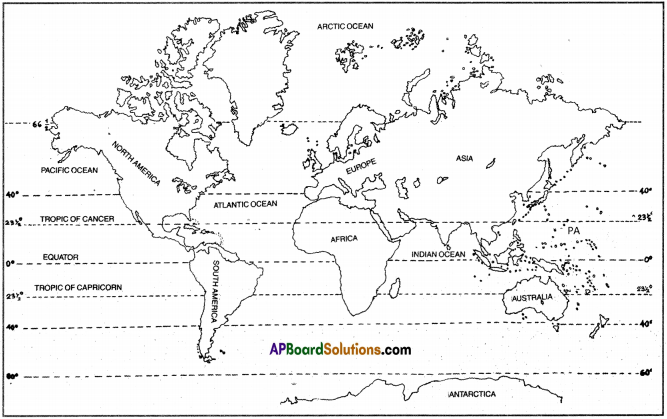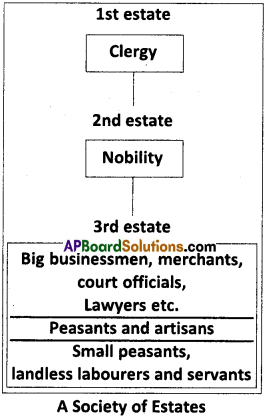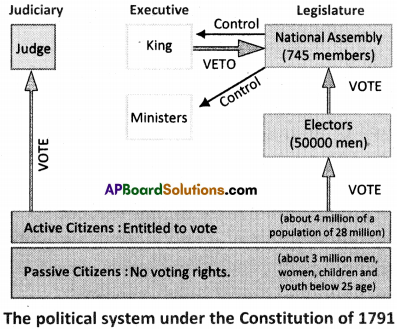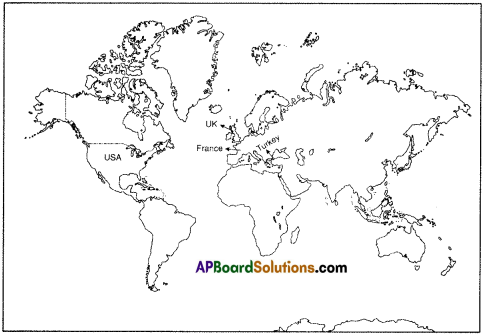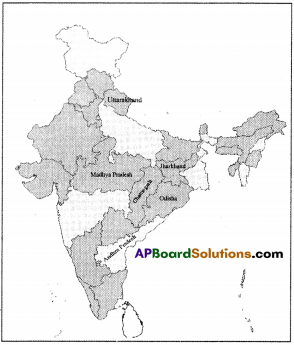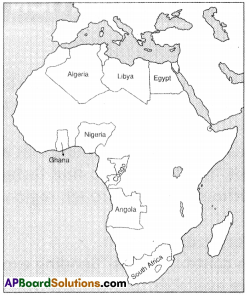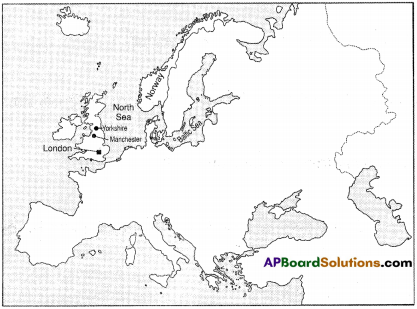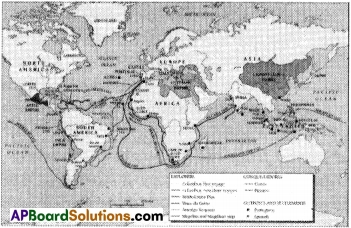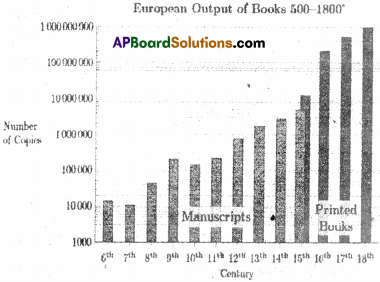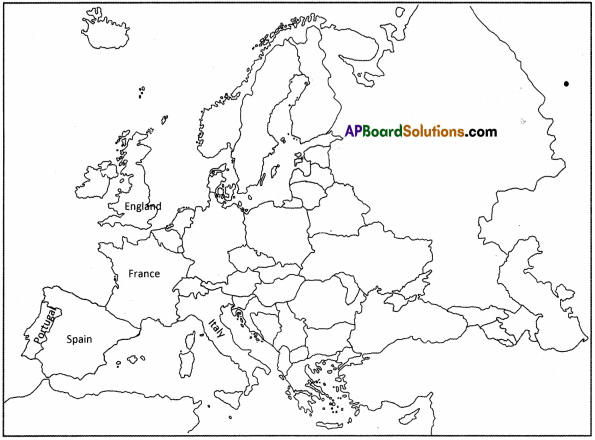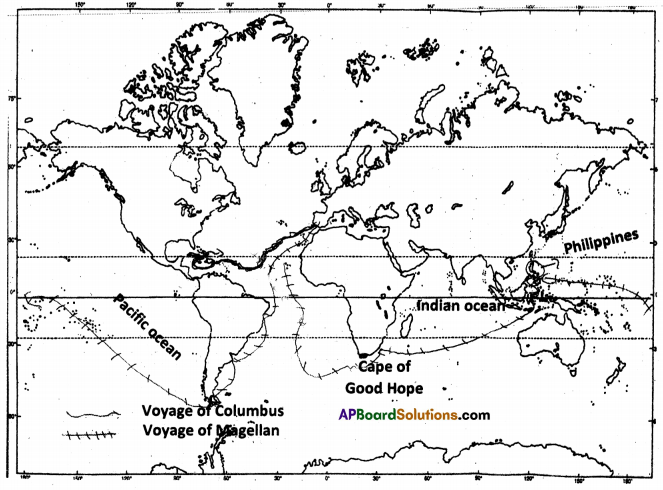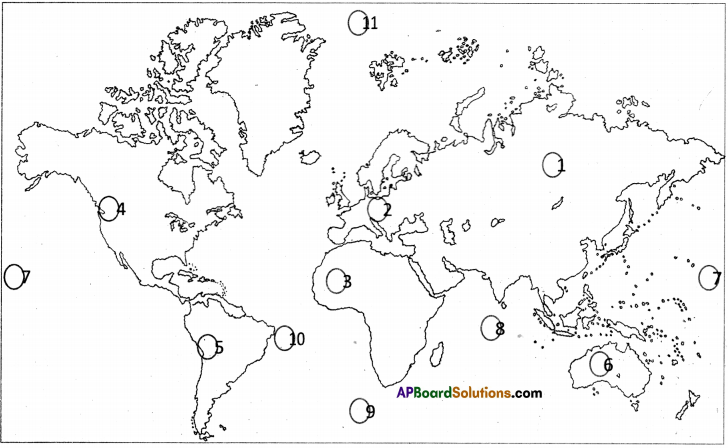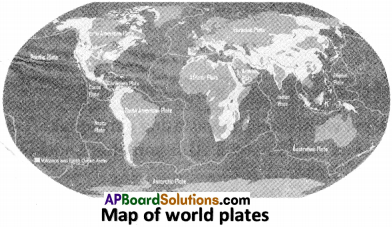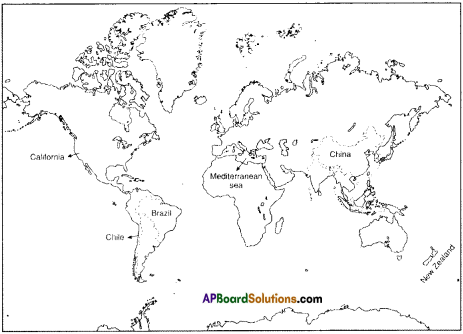AP State Syllabus AP Board 9th Class Social Studies Important Questions Chapter 6 Agriculture in India.
AP State Syllabus 9th Class Social Studies Important Questions 6th Lesson Agriculture in India
9th Class Social 6th Lesson Agriculture in India 1 Mark Important Questions and Answers
Question 1.
Expand MSP. (SA-II : 2016-17)
Answer:
Minimum Support Price
Question 2.
Draw sketch map of India and identify paddy cultivating state. (SA-II : 2016-17)
Asnwer:

Question 3.
Why is a MSP needed? (SA-II : 2017-18)
Answer:
The government sets the MSP so as to cover the cost of cultivation and allow a little bit of profit to the farmer.
Question 4.

Study the map and answer the following question. (SA-I : 2018-19)
What is major crop in the shaded areas of the map?
Answer:
Paddy.
Question 5.
Name any two cropping seasons in India? (SA-I : 2018-19)
Answer:
Kharif, Rabi, Zaid are the three cropping seasons.
9th Class Social 6th Lesson Agriculture in India 2 Marks Important Questions and Answers
Question 1.
At present we are using under ground water heavily and they reached an endangered stage, indicate measures to restore the ground water. (SA-III : 2015-16)
Answer:
The following steps are the measures to restore ground water.
- Vegetation like trees and grasses and bonds are used to enhance ground water.
- We follow watershed development projects.
- Rainwater harvesting should be practiced.
- Reduce the wastage of water.
Question 2.
Observe the Bar graphs and write your observations. (SA-II : 2016-17)
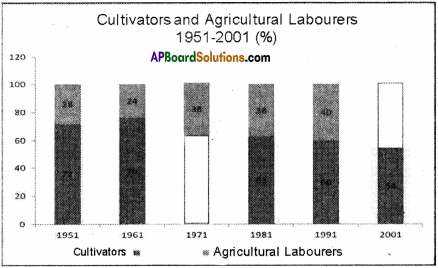
Answer:
- Above Bar graph tells us how many cultivators and how many agricultural labourers are there in India.
- Years are passing away gradually percentage of cultivators is decreasing and the persons, who are agricultural labourers are increasing
Question 3.
Show the below information on a bar graph and based on this, write your observation. (SA-III : 2016-17)
| Year |
Production of food grains in million tones |
| 1980-81 |
130 |
| 1990-91 |
176 |
| 2000-01 |
197 |
| 2010-11 |
242 |
Answer:
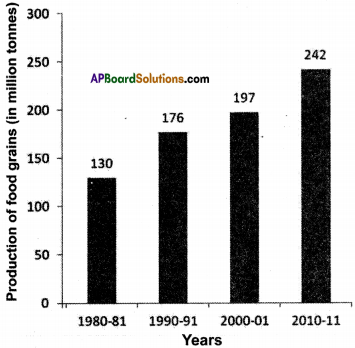
The above graph explains production of food grains is gradually increased from 1980-81 to 2010-11. The main reason is we are following green revolution methods in our agricultural iands.

Question 4.
Today food materials constitute only about three percent of Indian Imports. Explain the role of Green Revolution that lies behind this achievement. (SA-III : 2016-17)
Answer:
The production of food grains has increased five times over last five decades from 51 to 242 million tonnes.
The green revolution helped farmers to produce higher level of foodgrains and non- foodgrains on the same plot of land they had. There was no major increase in the land used for cultivation.
In 1960s a farmer was able to produce on an average only 287 kilograms of foodgrains be it paddy or wheat on one acre of cultivable land. Today the same farmer is able to produce nearly 800 kilograms of foodgrains per acre of cultivable land.
Importance of Green Revolution :
- Using of highyielding varieties of seeds.
- Using of pesticides and insecticides.
- Providing better water management resources.
Question 5.
Write the names of cropping seasons in India and write the tenure of season. (SA-II : 2017-18)
There are three cropping seasons.
| Crop |
Tenure |
| 1. Kharif |
Mid June to October |
| 2. Rabi |
November to March |
| 3. Zaid |
April, May, Mid June |
9th Class Social 6th Lesson Agriculture in India 4 Marks Important Questions and Answers
Question 1.
“The green revolution has resulted in a loss of soil fertility and ever increasing costs to farmers”. Do you agree with this statement? Explain. (SA-I : 2018-19)
(OR)
“The green revolution has actually resulted in a loss of soil fertility and ever increasing cost to the farmers’ (SA-II : 2018-19)
Do you agree with the above statement? Provides reasons to support your answer.
Answer:
Yes, I agree with the above statement by following reasons.
- In Green Revolution, the farmers are encouraged to pump ground water to water intensive crops in low rainfall areas.
- This unsustainable pumping has reduced water storage in ground.
- Consequently, many wells and tube wells have run dry.
- More over the use of chemical fertilizers has also affected the long term fertility of the soil. Due to this cost of production is increasing to farmers.
- Hence we can say that Green Revolution has short-term gains and long term losses.
- Production of food grains (in million tonnes)
Question 2.
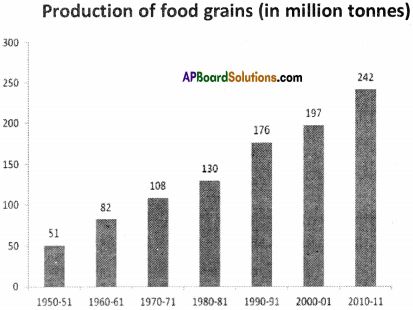
Observe the above graph and answer the following questions.
1. What does the graph given above denotes? (SA-III : 2015-16)
Answer:
The above graph explains the production of foodgrains from 1950-51 to 2010-11 years.
2. When compared to 1970-71, how many million tonnes of food grains are produced more in 2010-11? (SA-III : 2015-16)
Answer:
Compare with 1970-71 to 2010-11 the food grain production is increased from 108 million tonnes to 242 million tonnes, it means ⇔ 134 million tonnes production is more.
3. In which decade was the production of food grains more? (SA-III : 2015-16)
Answer:
From 1981 to 1990 in the middle of the years means, in this decade the production of food grains is more.
4. What are the reasons for the increase in production of food grains? (SA-III : 2015-16)
Answer:
The main reason is use of Green Revolution methods.
5. What is the overall trend of food grain production depicted in the graph? (SA-I : 2019-20)
Answer:
Food grain production is increasing.
6. What could be the possible reason for this trend? (SA-I : 2019-20)
Answer:
Because of Green Revolution.

Question 3.
“Conserving rainfall that the area receives is the first step. There are several ways that people can stop rainwater from quickly running off so that it can soak into the ground, and recharge the groundwater”.
Q : Comment on watershed development programms being implemented in dry land area. (SA-II : 2016-17)
Answer:
Unlike the cultivation of HYVs in irrigated lands, dryland farming possess different challenges.
- Conserving rainfall that the area receives is the first step.
- There are several ways that people can stop rain water from quickly running off, so that it can soak into the ground, and recharge the ground water.
This is done through Watershed Development Programmes which include afforestation, bunding, building check dams and tanks.
Not send any chemical waste into underground.
Try to reduce the wastage of daily use water.
Create awareness among the all people about the importance of underground water and its recharge.
Question 4.
Food security of a nation depends on agricultural sector. Explain about agricultural sector in India. (SA-III : 2016-17)
Answer:
The food security of a nation depends on agriculture and this sector ensures food security to the nation.
Importance of agriculture :
- A variety of raw materials required for industries are cultivated on farms.
- Agriculture is a major source of livelihood for millions – giving employment to a large section of people.
- More than half the proportion of workers in India is working in agriculture and its related activities.
- 70% of working women are engaged in agriculture.
- Due to green revolution, India became self sufficient in food grains.
- Due to rise in food grains production, it was no longer necessary to import food grains from other countries.
Question 5.
Study the graph and answer the questions given below. (SA-II : 2018-19)

1. What is the difference between agriculture labourers and cultivators?
2. In 1971, what was the percentage of cultivators?
3. Suggest other alternative job opportunities for landless agriculture labourers,
4. In which year the highest percentage of cultivators was recorded?
Answer:
1. Cultivator means:
Cultivators are those who have, some land and also use land belongs to other for cultivation.
Agricultural labourers :
Agriculture labourers are those who are landless labourers who work on other lands.
2. 62%
3. Other alternative works.
- rearing of animals
- selling of vegetables
- work in brick kiln.
4. 1961

Question 6.
What suggestions do you recommend to solve the problems associated with current Indian agriculture sector? (SA-I : 2018-19)
Answer:
Suggestions :
1. Better irrigation facilities :
Indian agriculture is mainly dependent on monsoon. So permanent means of irrigation should be developed.
Ex: Tube wells & Canals.
2. Supply of Quality seeds :
- Quality seeds should be sold through co-operative societies or village panchayats.
- Marginal farmers should be given seeds on loan.
3. Green Manure :
Farmers should be educated for firing green manure. Oil cakes may be used as fertilizers.
4. Credit Facilitied :
- Farmers should be advanced loans at reasonable rates of interest.
- Regional Rural Banks should be opened.
5. Agricultural Marketing:
Agricultural marketing should be improved so that the farmer gets proper price for their produce ware housing facilities should be improved. Means of transport should be strengthened.
6. Time to time weather reports telecast by govt through media.
Question 7.
Observe the table and answer the questions given below. (SA-I : 2018-19)
Number of farmers and land they possess in India (2010 – 2011)
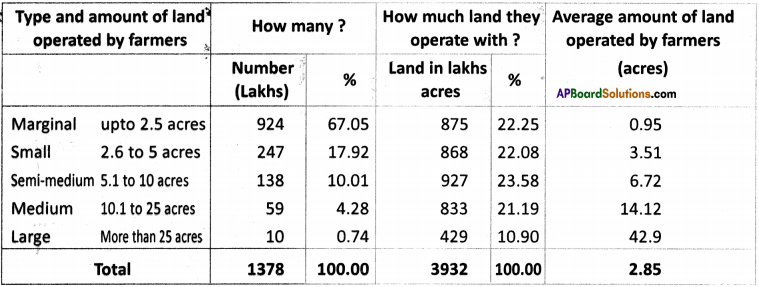
1. Who are considered as large farmers as per the above table?
2. Which type of farmers are high in number?
3. How many total acres of land do the farmers cultivate in India?
4. How much of land on an average does each marginal farmer cultivate?
Answer:
- The farmers who have more than 25 acres of land and they cultivated that land are called as large farmers.
- Number of marginal farmers are more.
- 3932 lakhs acres of land cultivated by Indian farmers.
- 0.95 acres of land is cultivated by marginal farmers.

Question 8.
Write some methods through which the problem of falling ground water levels can be salved. (SA-I : 2019-20)
Answer:
The problem of falling ground water levels can be solved through these methods.
- Construction of check dams.
- By Maintaining small percolation tanks in fields.
- Soaking pits.
- By providing bunds and catch drains.
- Plantation of trees in open fields.
- Encouragement to grow forests.
- Should ban felling trees.
- Recycle and reuse of ground water.
9th Class Social 6th Lesson Agriculture in India Important Questions and Answers
Question 1.
Name one staple crop of India and the regions where it is produced.
Answer:
Rice:
- Rice is the staple food crop of a majority of the people in India.
- India is the second largest producer of rice in the world.
- Rice is grown in the plains of north and north-eastern India, coastal areas and the deltaic regions.
- Canal irrigation and tubewells have made it possible to grow rice in areas of less rainfall such as Punjab, Haryana and western Uttar Pradesh and parts of Rajasthan.
Question 2.
How many cropping seasons are there? What are they?
Answer:
India has three cropping seasons. They are –
- Rabi
- Kharif
- Zaid

Question 3.
Name some important crops of India, states which produce them and reasons both and natural and other factors contributed to their growth.
Answer:

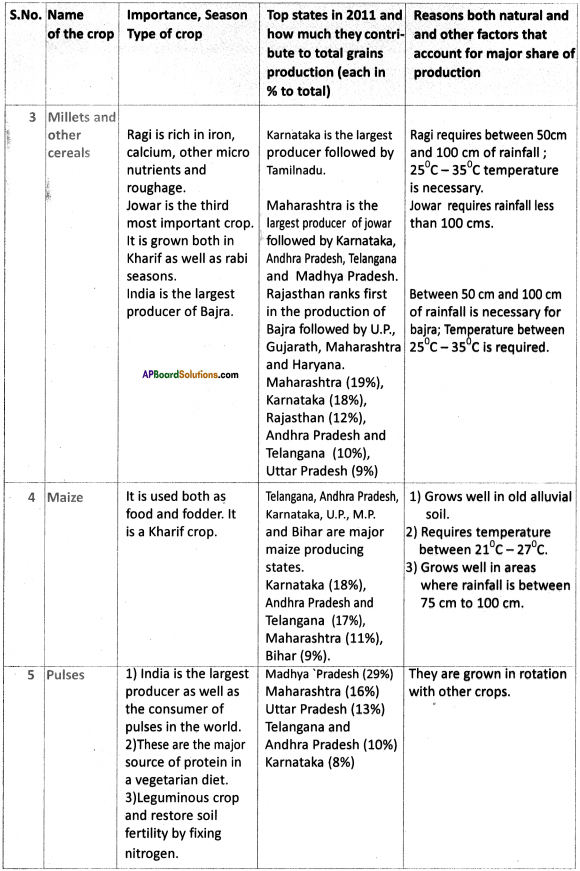

Question 4.
What is the fertility of the soil?
Answer:
- The soil is said to be fertile if it has the right amounts of mineral particles as well as organic components.
- Then only the soil can provide the roots of plants with right amounts of water, minerals and air.
Question 5.
How is organic farming different from traditional farming?
Answer:
- We use organic material in organic farming whereas we use natural manure in traditional farming.
- We use HYV seeds and key elements of new agricultural technologies in organic farming.
- Organic farming gives high productivity in short duration whereas in traditional farming we experience less productivity and long duration of crop.
Question 6.
Why is agriculture important to Indian economy?
Answer:
- The food security of a nation depends on agriculture.
- A variety of raw materials required for industries are cultivated on farms.
- Agriculture is a major source of livelihood for millions of people in our country.
- More than half the proportion of workers in India is working in agriculture and its related activities.
- Nearly 70% of the working women are engaged in agriculture.
Hence agriculture is important to Indian economy.

Question 7.
How many kinds of people are engaged in agriculture? Name them.
Answer:
Two kinds of people are engaged in farming. They are :
- Agricultural labourers
- Cultivators.
Question 8.
Distinguish between cultivators and agricultural labourers.
Answer:
| Cultivators |
Agricultural labourers |
| 1. Cultivators are those who have some land and also use land belongs to others for cultivation. |
1. Agriculture labourers are those who are landless labourers who work on others’ lands. |
| 2. Cultivators are self employed. |
2. Whereas agricultural labourers have to depended on working on others’ fields for livelihood. |
Question 9.
How many varieties of crops are grown in India? What are they?
Answer:
A variety of crops are cultivated by farmers in India. They are broadly categorised into two :
- Food crops
- Non-food crops.

Question 10.
Give examples of food grains and non-food grains.
Answer:
- Food grains include cereals such as rice, wheat, jowar, bajra, maize, ragi, barley, and small millets and pulses-gram, red gram, and other pulses.
- Non-food grains include oilseeds such as groundnut, sesame, rapeseed and mustard, linseed, castor seed, and sunflower, etc.
Question 11.
What is Green Revolution? What are the effects of Green Revolution?
Answer:
- The policy introduced by Government with regard to the agricultural sector is known as Green Revolutin.
- It refers to the specific plant improvement notably to the development of high yielding varieties for the increase of crop production.
Effects of Green Revolution:
- The spread of HYVs to large parts of the country has led to a significant increase in crop production in the country.
- So, it was no longer necessary to import food grains from other countries.
- The procurement of food grains by FCI could be used in case of shortage and can avoid drought or famine like situations and also used to supply food grains to inaccessible areas.
- In 1960, a farmer was able to produce on an average of 287 kgs of foodgrains, today the same farmer is able to produce nearly 800 kgs of food grains per acre.
- The Green Revolution has brought in several environmental imbalances.
Question 12.
Name some of the states of India where “slash and burning” farming is practised.
Answer:
Punjab, Haryana, Odisha, Karnataka, Telangana, Andhra Pradesh, Madhya Pradesh, Uttar Pradesh, and some parts of Rajasthan.

Question 13.
What is the fertility of the soil?
Answer:
- The soil is said to be fertile if it has the right amounts of mineral particles as well as organic components.
- Then only the soil can provide the roots of plants with right amounts of water, minerals, and air.
Question 14.
How many kinds of people are engaged in agriculture? Name them.
Answer:
Two kinds of people are engaged in farming. They are :
- Agricultural labourers
- Cultivators.
Question 15.
What is Green Revolution?
Answer:
The policy introduced by Government with regard to the agricultural sector is known as Green Revolution.
Question 16.
Compare and contrast simple subsistence farming and intensive subsistence farming.
Answer:
| Simple subsistence farming |
Intensive Substitence farming |
| 1. Agriculture is practiced in small patches of land. |
1. Practised in the areas of high population density. |
| 2. Primitive tools like hoe, dao and digging sticks are used. |
2. No primitive tools are used but mechanised tools. |
| 3. Family or community labour is the source of labour. |
3. It is labour intensive farming. |
| 4. Natural fertility of the soil, monsoon etc. are important. |
4. High doses of biochemical inputs are used. |
| 5. It is a ‘slash and burn1 agriculture. |
5. Irrigation is used to obtain higher production. |
Question 17.
What do you know about Zaid cropping season?
Answer:
- In between the Rabi and Kharif seasons there is a short season.
- It includes summer months and is known as Zaid season.
- Crops grown during this season are like watermelon, muskmelon, cucumber, vegetables and fodder crops.

Question 18.
Read the following and answer the questions given below.
|
Why does Government buys and stores some grain?
A lot of grain comes into the market at harvest time. One problem farmers faced was the low price of grain during this time. This means farmers were not able to sell grain at a high enough price to be able to repay their loans and continue using the new farming methods. They need to be protected from traders who might try to purchase the grains at low prices.
Therefore, the government decided to set a Minimum Support Price (MSP). A Mini¬mum Support Price is a price at which the farmers can sell their grain, if they want, to the government. The government sets the MSP so as to cover the cost of cultivation and allow a little bit of profit to the farmer. Because of the MSP, farmers are not forced to sell their grains at cheaper prices to the traders.
The Food Corporation of India (FCI) was formed by the government to purchase food grains from the farmers and store them. It keeps stockpiles and supplies grain to ration shops and other government schemes (e.g. for midday meals in schools). |
1. What problem do farmers face during harvest season?
Answer:
The farmers face the problem of the low price of grain during harvest season.
2. How can the farmers be protected from the low prices of grains?
Answer:
The government protects the farmers by setting a Minimum Support Price (MSP).
3. What is Minimum Support Price?
Answer:
The MSP is a price at which the farmers can sell their grain, if they want, to the government.
4. How does the MSP protect the farmer?
Answer:
The government sets the MSP so as to cover the cost of cultivation and allow a little bit of profit to the farmer.
5. What is the organization that purchases food grains from the farmers?
Answer:
The Food Corporation India purchases food grains from the farmers.
Question 19.
Observe the following information and answer the questions given below.
| Cropping seasons |
Period |
Crops grown |
| Kharif |
They are grown with the onset of monsoons, harvested in September to October. |
Paddy, maize, jower, bajra, red gram, green gram, black gram, cotton, jute, groundnut, etc. |
| Rabi |
They are sown in winter from October – December and harvested in summer. |
Wheat, barley, peas, gram and mustard. |
| Zaid |
In between Rabi and Kharif there is a short period during summer months known as the zaid season. |
Watermelon, muskmelon, cucumber, vegetables and fodder crops. |
1. How many cropping seasons are there?
Answer:
There are three cropping seasons.
2. Name different cropping seasons.
Answer:
Kharif, Rabi and Zaid are different cropping seasons.
3. When do we have Rabi season?
Answer:
Rabi crops are sown in winter from October to December and harvested in summer.
4. Name the crops that are grown in Kharif season.
Answer:
Paddy, maize, jower, bajra, red gram, cotton, jute, groundnut etc., are grown in Kharif season.
5. Name the crops that are grown in Zaid season.
Answer:
Watermelon, muskmelon, cucumber, vegetables are grown in Zaid season.

Question 20.
Complete the data in the table:
Number of farmers and land they possess in India (2010-2011)
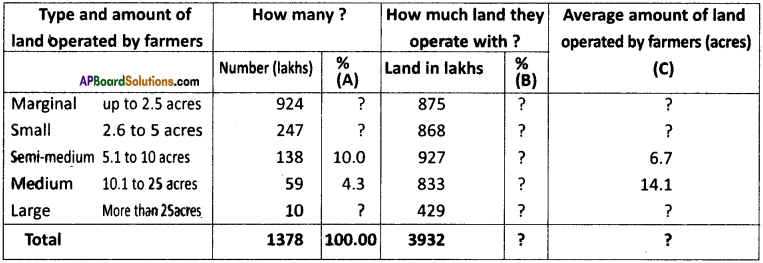
A) Percentage of different category of farmers :
1. How much percentage of Marginal farmers are there.
Answer:
67 %
2. How much percentage of small farmers are there?
Answwr:
18 %
3. How much percentage of large farmers are there?
Answer:
0.7 %
B) How much land they operate with?
1) Marginal farmers hold _________ of land.
2) Small farmers hold _________ of land.
3) Semi-medium farmers hold _________ of land.
4) Medium farmers hold _________ of land.
5) Large farmers hold _________ of land.
Answer:
- 22%
- 22%
- 24%
- 21%
- 11%
C) Average amount of land operated by farmers :
1) Average amount of land possessed by marginal farmers is _________ acres.
2) Small farmers hold _________ acres of land.
3) Average amount of land possessed by large farmers is _________ acres.
4) Average land holding in India is _________ acres.
Answer:
- 0.94
- 3.51
- 42.9
- 13.65
Question 21.
What are the long run uses of chemical fertilizers and pesticides?
Answer:
- The chemical fertilizers are basically made from petro chemicals and therefore derived from petroleum.
- These fertilizers remain in the soil and also mix with water.
- This results in the contamination of soil and water.
- As a result many micro organisms like earthworms are destroyed. This in turn affects the long term fertility of the soil.

Question 22.
In which areas were the new methods of agriculture first tried?
Answer:
The new methods were initially implemented in Punjab, Haryana, western Uttar Pradesh, and in some districts of Telangana, Andhra Pradesh, and Tamilnadu.
Question 23.
How were farmers able to raise higher amount of food grains on the same plot of land over the years?
Answer:
The use of High Yielding Varieties of seeds, chemical fertilizers, machinery, etc. made the farmers to raise higher amount of food grains on the same plot of land over the years.
Question 24.
Why did the Indian government not allow farmers to export foodgrains during the Green Revolution?
Answer:
There would be a shortage of food grains if the government allows farmers to export food grains. So the government did not allow farmers to export food grains.
Question 25.
How did the partition of the country in 1947 affect the jute industry?
Answer:
We have lost the major jute growing areas during partition. Hence the jute industry was badly affected.

Question 26.
In your opinion what would be the minimum amount of land required to do viable farming?
Answer:
The minimum amount of land required to do viable farming maybe 2 acres for viable farming.
Question 27.
Why do only a small section of farmers have a powerful voice?
Answer:
Percentage of large and medium farmers is 5% but they hold 32% of total cultivable land. Their average landholding is also high. Hence they have a powerful voice.
Question 28.
Assess the role of monsoons in Indian agriculture nowadays?
Answer:
- Indian agriculture has always been dependent on monsoons.
- Arrival and impact of monsoon decides the fate of agriculture.
- It is both uncertain and irregular.
- The large scale irrigation serves only one third of crop area.
- The remaining has to suffer the vagaries of the monsoon.
- Thus one can term Indian agriculture as ‘a gamble with monsoons.’
Question 29.
How can you say that now India is practising subsistence farming?
Answer:
- India is a densely populated country.
- Farmers here are force to use small land holdings.
- Most farmers produce enough for their own consumption.
- They try to obtain maximum yield from available lands.
- They are artificial irrigation and manure etc.
- This type of farming is known as intensive subsistence farming.
- Thus we can say India is practising subsistence farming.

Question 30.
Do you feel that the farmers who cultivate are happy? If not, what are the reasons? What are the factors that affect agriculture?
Answer:
I feel that the farmers who cultivate are not happy.
Reasons:
- They are not able to earn according to their labour.
- They lost their confidence.
- Nature is also not co-operating with them.
Factors that affect agriculture :
- Low fertile soils
- Improper usage of pesticides
- Small land holdings
- Unpredictable monsoons
- Outdated agricultural methods
- Improper market facilities, etc.
Question 31.
Locate the following on India Map.
Paddy, wheat and maize growing areas.
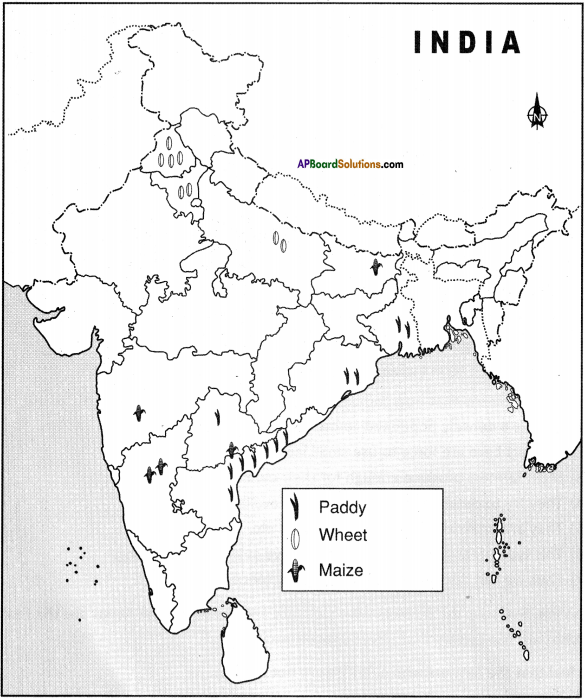
Answer:
Paddy – West Bengal, Odisha, Telangana, Andhra Pradesh and coastal areas.
Wheat – Punjab, Haryana, Uttar Pradesh
Maize – Karnataka, Telangana, Andhra Pradesh, Maharashtra and Bihar.
Question 32.
Locate the following on India map.
Pulses, sugarcane, cotton growing areas.
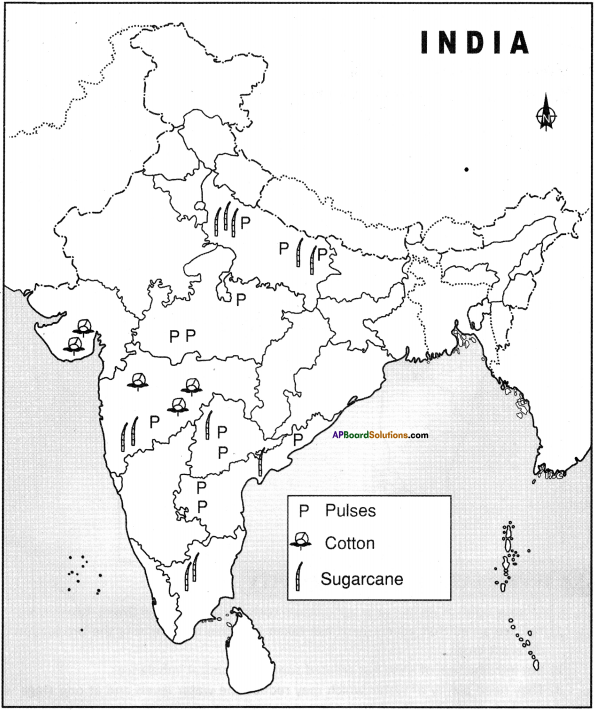
Answer:
Pulses – Madhya Pradesh, Maharashtra, Uttar Pradesh, Telangana and Andhra Pradesh.
Cotton – Gujarat, Maharashtra.
Sugarcane – Uttar Pradesh, Maharashtra, Telangana, Andhra Pradesh, Tamilnadu.

Question 32.
Locate the following rivers on the outline map of India.
1) Narmada
2) Tapati
3) Godavari
4) Krishna
5) Cauvery
6) Mahanadi
7) Indus
8) Ganga
Answer:
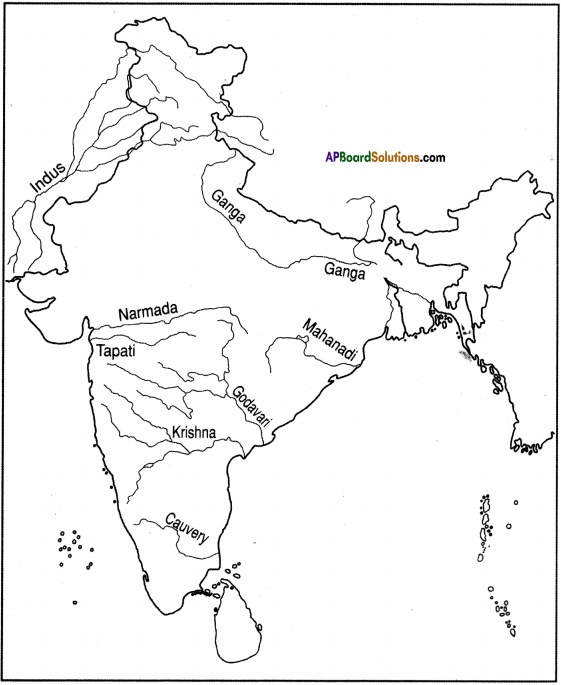
Question 33.
State your opinion on the new agricultural technologies such as Green Revolution.
Answer:
- Yes, we agree that government has taken initiative in increasing the production of different crops.
- But introduction of HYVs has created some economical imbalances.
- They need plenty of water which may reduce the water levels and at one stage we would face scarcity of water.
Question 34.
State your opinion on free power supply to farmers and the problems that are faced by marginal farmers due to free power supply.
Answer:
- Free power supply to a section of farmers has encouraged them to pump groundwater.
- Consequently, many wells and tubewells have run dry.
- This has pushed the marginal and small farmers out of cultivation.
Question 35.
How did the partition of the country in 1947 affect the Jute industry?
Answer:
We have lost the major jute growing areas during partition. Hence the jute industry was badly affected.

Question 36.
What measures would you suggest to protect agriculture from intense commercial farming?
Answer:
- To protect agriculture from intense commercial farming, we should shun the use of High Yielding Varieties of Seeds.
- Then we can limit the usage of water.
- Then we can limit the usage of chemical fertilisers and pesticides.
- We can save the produce for seeds.
- We can adopt organic farming, which requires very low input costs.
- Organic farm produce also serves health better.
Question 37.
What measures would you suggest for the cultivation of cotton crop?
Answer:
- Cotton grows well in drier parts of the black cotton soil of the Deccan Plateau.
- It requires high temperature, light rainfall or irrigation.
- It needs 210 frost free days and bright sunshine for its growth.
- It requires 6 to 8 months to mature.
![]()
![]()


![]()
![]()

![]()
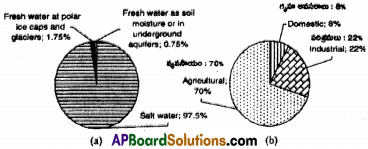 (SA-I: 2019-20)
(SA-I: 2019-20)

